Standards Worldwide
Standards Worldwide
Phone +49 30 58885700-07

Standard [CURRENT]
ASTM D 8184:2018
Standard Test Method for Ferrous Wear Debris Monitoring in In-Service Fluids Using a Particle Quantifier Instrument
- Publication date
- 2018
- Original language
- English
- Pages
- 7
- Publication date
- 2018
- Original language
- English
- Pages
- 7
Product information on this site:
Quick delivery via download or delivery service
Buy securely with a credit card or pay upon receipt of invoice
All transactions are encrypted
Short description
1.1 This test method describes the use of offline particle quantification (often referred to as PQ) magnetometers to trend wear rates in machinery by monitoring the amount of ferromagnetic material suspended in a fluid sample that has been in contact with the moving parts of the machinery. It is particularly relevant to monitoring wear debris in lubricating oils and greases. 1.2 The values stated in SI units are to be regarded as standard. Values of the burden (mass) of ferrous wear debris in the sample are reported as a PQ Index. The PQ Index is a numerical value that scales with the ferrous debris burden. 1.3 This standard does not purport to address all of the safety concerns, if any, associated with its use. It is the responsibility of the user of this standard to establish appropriate safety, health, and environmental practices and determine the applicability of regulatory limitations prior to use. 1.4 This international standard was developed in accordance with internationally recognized principles on standardization established in the Decision on Principles for the Development of International Standards, Guides and Recommendations issued by the World Trade Organization Technical Barriers to Trade (TBT) Committee.
Also available in
Loading recommended items...
Loading recommended items...
Loading recommended items...
Loading recommended items...
